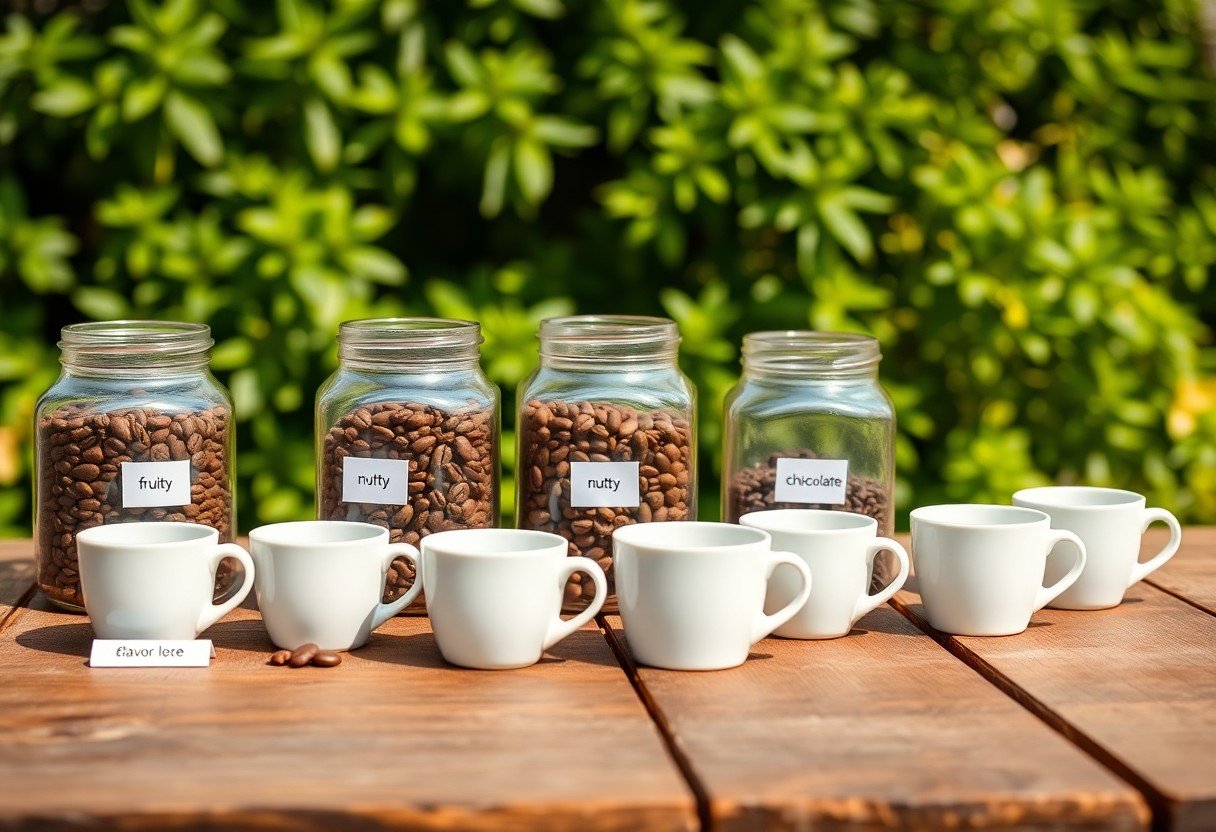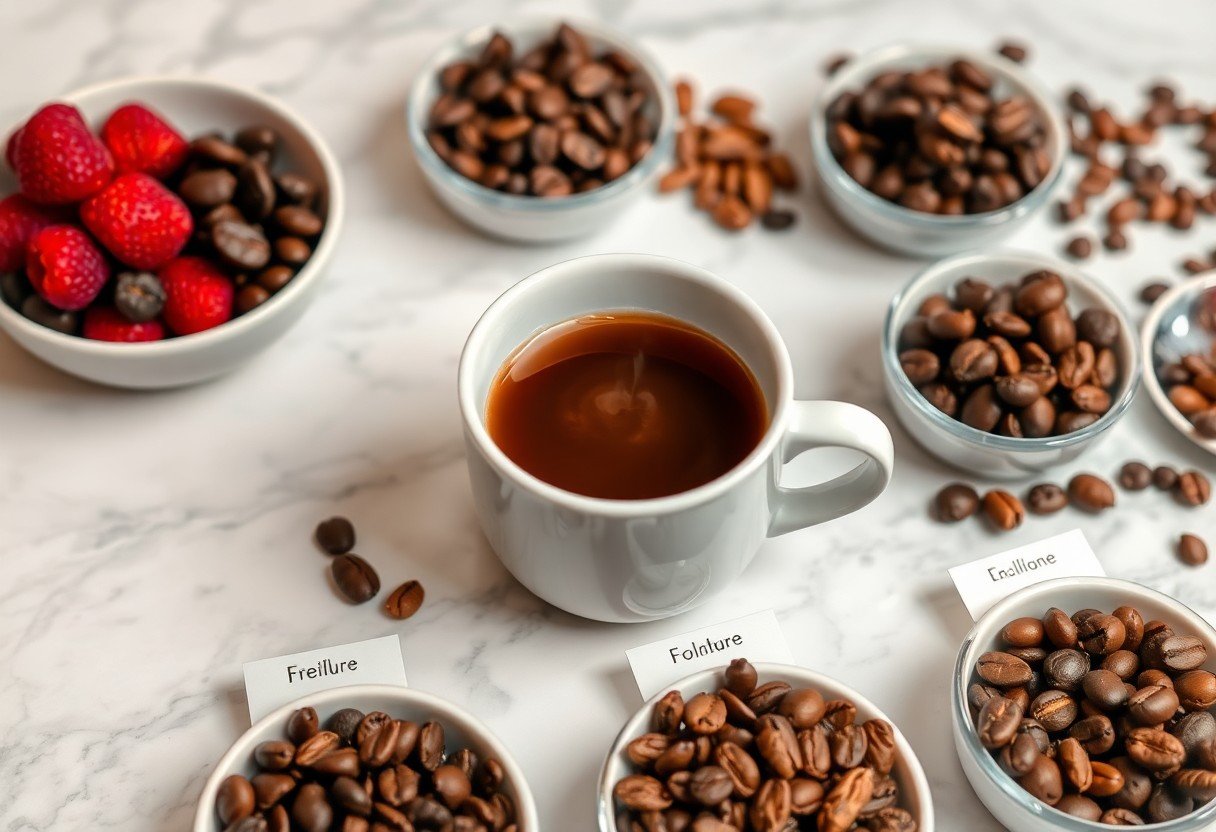Over countless cups of coffee, you may have noticed a diverse range of flavors that define artisan brews. Understanding these unique flavor profiles, from vibrant fruity notes to rich chocolaty undertones, can significantly enhance your coffee experience. This guide will help you navigate the world of artisan coffee, offering insights into how different beans, processing methods, and roasting techniques contribute to the complex tastes you enjoy in your favorite cup.
The Spectrum of Artisan Coffee Flavors
Artisan coffee offers a vast array of flavors, each varying dramatically based on factors like origin, processing methods, and roast profiles. From the bright and refreshing notes reminiscent of summer fruits to deep, rich chocolates, every cup tells a distinct story. Understanding this spectrum can elevate your coffee experience, allowing you to discern and appreciate the nuanced complexity within each sip.
From Bright and Fruity: Exploring Citrus and Berry Notes
Bright and fruity coffee profiles often shine with vivid citrus and berry notes. You may encounter flavors such as zesty lemon, juicy orange, or ripe berry that invigorate your senses. Coffees from areas like Ethiopia are renowned for their floral and fruity characteristics, delivering a lively taste that captures the essence of fresh produce.
The Savor of Spice: Understanding Herbal and Earthy Undertones
Herbal and earthy undertones provide a grounding balance in coffee, introducing complexities that can enhance your palate. These flavors, often found in coffees from regions like Sumatra, bring forth a savory richness akin to herbal teas or fresh earth after a rain, adding depth to the overall experience.
Exploring herbal and earthy undertones reveals a fascinating layer to artisan coffee. The incorporation of spices like cinnamon or hints of basil can give your coffee a unique profile, enhancing aromatic richness. For instance, a dark roast from a specific region may display earthy traits that blend seamlessly with a subtle spiciness, reminiscent of warm chai. This complexity not only enriches flavor but also connects you to the coffee’s origin, showcasing the diverse climates and soils contributing to your cup’s unique taste. Understanding these elements allows you to appreciate each sip with newfound depth.

The Role of Region in Flavor Development
The geographical region where coffee is grown dramatically influences its flavor profile. Factors such as elevation, humidity, and the local ecosystem play imperative roles in defining the taste of your cup. For instance, coffees grown at high altitudes tend to have brighter acidity and more complex flavors, while those cultivated in warmer climates often showcase richer, bolder profiles. Understanding these regional differences can deepen your appreciation of each brew and enhance your tasting experience.
The Influence of Terroir: How Soil and Climate Shape Taste
Terroir, encompassing the unique combination of soil, climate, and local agricultural practices, is fundamental in shaping coffee flavor. Varietals grown in volcanic soils, like those in certain Ethiopian regions, yield coffee with vibrant fruit notes. Conversely, coffee from lower, wetter areas may develop heavier bodies and sugary sweetness. By recognizing these influences, you become more adept at discerning the nuances in your coffee.
Notable Coffee Regions: Profiles of Ethiopia, Colombia, and Guatemala
Ethiopia, often hailed as the birthplace of coffee, delivers an array of fruity and floral flavors, with notable varieties like Yirgacheffe showcasing vibrant citrus and berry notes. Colombian coffee typically balances smoothness with a mild flavor profile, often featuring hints of nuts and caramel. Guatemala offers a diverse palate where high-altitude coffees provide a complex combination of chocolatey and spicy undertones, perfect for those seeking depth in taste.
Each of these regions exemplifies the impact of local conditions on flavor profiles. Ethiopian coffees, cultivated at high altitudes and known for their unique heirloom varietals, present a wide range of flavors from jasmine to wild berries. Colombian beans, primarily grown in the lush foothills of the Andes, are characterized by their smooth, well-rounded profiles, and often delight with nutty and caramel notes. Guatemalan coffees from regions like Antigua benefit from volcanic soil and cool climates, leading to rich, full-bodied brews with complex flavors of chocolate and spice. Understanding these profiles equips you to choose coffees that align with your personal tastes and preferences.
Roasting Techniques: Unlocking Hidden Flavors
Roasting is an art that transforms raw green beans into aromatic coffee, revealing complex flavors and aromas. The degree and method of roasting not only affect the final taste but also unlock hidden flavor notes that are otherwise muted. Mastering different roasting techniques helps you achieve specific flavor profiles, from the bright acidity found in lighter roasts to the deep, rich tones of darker varieties. Understanding these techniques allows you to tailor your coffee experience based on your personal preferences.
Light vs Dark Roasts: Color and Flavor Relationships
The color of roasted coffee beans directly correlates with their flavor. Light roasts exhibit a vibrant, fruity acidity, often showcasing the origin’s unique characteristics. In contrast, dark roasts develop a bold, bittersweet profile with chocolate and caramel notes, often overshadowing the bean’s original taste. By adjusting the roast level, you can emphasize or mute specific flavor attributes, allowing for a dynamic coffee experience tailored to your palate.
The Science of Roasting: Chemical Reactions That Enhance Taste
Roasting initiates a series of chemical reactions that shape the flavor profile of coffee. The Maillard reaction, which occurs between the amino acids and sugars, gives rise to distinctive caramelized notes, while the creation of volatile compounds enhances aroma. Carbon dioxide released during roasting also plays a role, contributing to body and mouthfeel. Understanding these processes can help you appreciate the complexity of your coffee and guide you in selecting beans that bring out the flavors you love.
As beans undergo roasting, the temperature increases, triggering a transformation known as the Maillard reaction, which begins at around 140°C (284°F). This reaction contributes to the development of rich flavors and aromas, layering complexity into your cup. At higher temperatures, sugars caramelize, yielding sweet, nutty flavors that are characteristic of medium to dark roasts. Additionally, the breakdown of chlorogenic acids creates acidity that balances sweetness and body, while enhancing fruity and floral notes in lighter roasts. By understanding these chemical dynamics, you can select roast levels that complement your taste preferences and elevate your coffee-drinking experience.
Tasting Coffee Like a Pro
Exploring coffee tasting can elevate your appreciation and understanding of different flavor profiles. Approach each tasting with an open mind, focusing on specific attributes such as acidity, body, and aftertaste. Utilize your senses fully by observing the aroma, taking small sips, and letting the coffee linger in your mouth to identify distinct flavors. Noting your observations helps to refine your palate over time, making you a more discerning taster.
Developing Your Palate: Techniques for Flavor Detection
Enhancing your flavor detection starts with honing your observational skills. Try tasting a variety of coffees side by side, paying attention to their unique attributes. Use flavor wheels, which visually represent various taste notes, to guide your exploration. Engaging in mindful tasting, where you focus entirely on the experience without distractions, fosters a deeper connection to each coffee’s complexity.
Coffee Tasting Events: What to Expect and How to Prepare
Coffee tasting events provide a unique opportunity to expand your knowledge and refine your palate alongside fellow enthusiasts. Attend with an open mind, ready to taste multiple coffee varieties from different regions. Bring a notebook to jot down your thoughts and experiences, and make sure to ask questions to gain insights from baristas and roasters.
At coffee tasting events, expect a wide array of coffee samples, often arranged by flavor profiles for comparative tasting. Stations may include descriptions of each coffee’s origin and preparation methods, allowing you to connect flavor to context. Preparing by familiarizing yourself with basic coffee terminology can enhance your experience, enabling you to engage more actively with experts during discussions. Sampling food pairings, if offered, can also enrich your understanding of how different flavors interact with various coffees.

Pairing Coffee with Food: Elevating the Experience
Pairing artisan coffee with food enhances the tasting experience, allowing flavors to complement and elevate each other. As you explore different coffees, consider how the flavor profiles interact with your meal. A well-chosen coffee can highlight the sweetness of desserts or cut through the richness of savory dishes, creating a harmonious balance that delights the palate.
Complementary Flavors: Crafting the Perfect Match
Crafting the perfect match involves understanding how flavors can enhance one another. A bright, fruity coffee pairs beautifully with lighter fare, while robust, chocolaty blends shine alongside richer dishes. Pay attention to acidity levels and sweetness in both food and coffee to achieve an ideal synergy that heightens your overall dining experience.
Popular Pairings: Tried and True Combinations
Exploring popular pairings reveals classic combinations that many coffee enthusiasts swear by. A light Ethiopian brew often complements fresh fruit salads, while a dark roast Italian espresso enhances the depth of chocolate desserts. Likewise, a medium-bodied Colombian coffee does wonders with breakfast pastries, providing balance and richness that elevates your meal.
Popular pairings such as a smooth Guatemalan pour-over with almond croissants are widely embraced for their complementary profiles, where the nutty notes of the pastry enhance the coffee’s inherent sweetness. The combination of a bold French roast with a rich chocolate torte is celebrated for creating an indulgent experience, where the coffee’s bitterness perfectly contrasts with the dessert’s sweetness. Experimenting with these established pairings allows you to discover and refine your favorite matches, transforming each coffee moment into a personalized culinary adventure.
Summing up
Now that you understand the diverse flavor profiles of artisan coffee, from fruity notes to rich chocolaty undertones, you can confidently explore and select brews that align with your palate. By identifying the specific tastes you enjoy, you enhance your coffee experience and deepen your appreciation for this rich beverage. Embrace the journey of tasting, and let your preferences guide you in discovering exceptional varieties that elevate your daily coffee ritual.
FAQ
Q: What are the common flavor profiles found in artisan coffee?
A: Common flavor profiles in artisan coffee include fruity, chocolaty, nutty, floral, and spicy. Each profile can vary significantly based on the origin of the beans, processing methods, and roasting techniques.
Q: How do fruity flavor profiles develop in coffee?
A: Fruity flavors develop from the coffee cherries during the growing process. Factors such as the coffee variety, terroir, and processing method (like natural processing) enhance these flavors, resulting in notes like berry, citrus, and tropical fruits.
Q: What contributes to chocolaty flavor notes in coffee?
A: Chocolaty flavor notes are often attributed to the Maillard reaction during roasting, which develops caramelization and sweetness. Beans from specific regions, like Colombia or Brazil, may naturally have these profiles, lending rich chocolate undertones to the cup.
Q: How can I identify floral notes in artisan coffee?
A: Floral notes can be identified through aromatic characteristics and the overall flavor profile. Beans from regions like Ethiopia often have bright, aromatic qualities that resemble flowers, such as jasmine or rose, especially in lighter roasts.
Q: Can processing methods affect the flavor profiles of artisan coffee?
A: Yes, processing methods significantly affect flavor profiles. For instance, natural processing can enhance fruitiness, while washed processing often leads to a cleaner taste with a focus on acidity and clarity. Each method can highlight different aspects of the coffee’s flavor.

